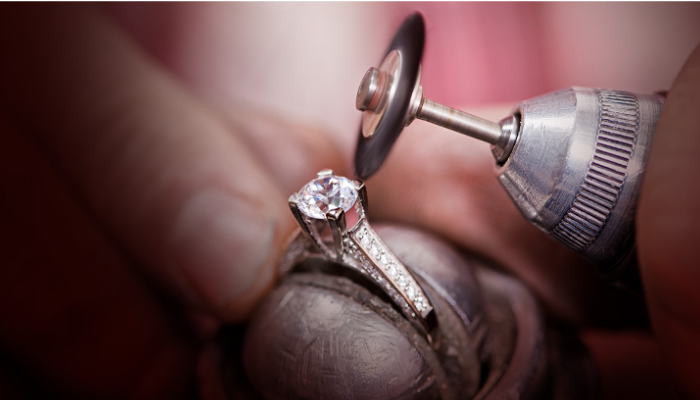
Jewellery goes beyond being an accessory; it mirrors our style, memories and, sometimes, our heritage. However, even the dearest items can fall victim to the effects of time and use. This is where the skill of jewellery restoration becomes essential. Whether it’s replacing clasps or delicately setting stones, having knowledge about these repairs can aid in preserving your treasured pieces’ lustre for years to come. Let’s explore the realm of jewellery restoration and unravel the age techniques that artisans have been perfecting over centuries.
The Importance of Jewellery Maintenance
Before we delve into specific repairs, it’s crucial to understand why jewellery maintenance matters. Regular care and timely repairs can:
- Extend the life of your jewellery
- Prevent small issues from becoming major problems
- Maintain the value of your pieces
- Ensure the safety of precious stones
- Keep your jewellery looking its best
Think of jewellery maintenance as you would car maintenance. Just as you wouldn’t ignore a strange noise in your engine, you shouldn’t overlook a loose stone or worn clasp in your favourite necklace.
Clasp Replacement: The Unsung Hero of Jewellery Repairs
When it comes to jewellery repairs, clasp replacement might not be the first thing that comes to mind. However, it’s one of the most common and crucial fixes in the industry. A faulty clasp can lead to lost necklaces or bracelets, making it a repair you can’t afford to ignore.
Types of Clasps and Their Functions
Clasps come in various styles, each suited for different types of jewellery:
- Spring ring clasps: Common on necklaces and light bracelets
- Lobster claw clasps: Secure and easy to use, popular on various pieces
- Box clasps: Often found on pearl necklaces and heavier bracelets
- Toggle clasps: Decorative and functional, used on both necklaces and bracelets
- Magnetic clasps: Easy to use, especially for those with dexterity issues
Signs Your Clasp Needs Replacing
Watch out for these red flags:
- Difficulty opening or closing the clasp
- Visible wear or damage
- The clasp opens unexpectedly
- Discoloration or tarnishing
The Clasp Replacement Process
While the exact process may vary depending on the type of clasp and jewellery, here’s a general overview:
- The jeweller removes the old clasp
- They prepare the chain end
- A new clasp is selected based on style and strength needs
- The new clasp is attached using soldering or other secure methods
- The jeweller polishes and cleans the piece
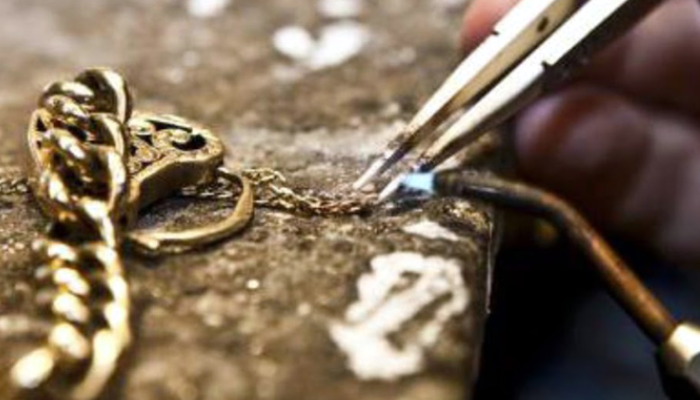
DIY vs. Professional Clasp Replacement
While some simple clasps can be replaced at home with basic tools, it’s often best to seek professional help. A jewellery repair service can ensure the new clasp is securely attached and matches the quality of your piece.
Chain Repair: Mending Broken Links
A broken chain can be heartbreaking, especially if it’s attached to a cherished pendant. Fortunately, chain repair is a common service offered by most jewellers.
Common Causes of Chain Damage
- Snagging on clothing or hair
- Excessive tension or pulling
- Normal wear and tear
- Poor quality or thin chains
Types of Chain Repairs
- Link replacement: For chains with one or two broken links
- Reattachment: When the chain has separated at the clasp
- Soldering: For more severe breaks or multiple damaged links
- Reconstruction: In cases of extensive damage
The Chain Repair Process
- The jeweller assesses the damage
- They clean the chain thoroughly
- Broken links are removed or repaired
- New links are added if necessary
- The chain is resoldered and polished
“A well-repaired chain should be indistinguishable from a new one.” – Expert Jeweller at The Jewellery Mechanic

Ring Resizing: Ensuring the Perfect Fit
Ring resizing is one of the most requested jewellery repairs. Whether your ring is too tight, too loose, or you’re passing down a family heirloom, ring resizing can make a world of difference.
Why Rings Might Need Resizing
- Weight loss or gain
- Swelling due to temperature or health conditions
- Inheriting or purchasing a pre-owned ring
- Changes in finger size due to ageing
The Ring Resizing Process Explained
For making a ring smaller:
- The jeweller cuts out a small section of the band
- They rejoin the ends and solder them together
- The ring is reshaped and polished
For making a ring larger:
- The band is cut
- A small piece of metal is added
- The new section is soldered in place
- The ring is reshaped and polished
Limitations of Ring Resizing
Not all rings can be resized. Factors that may limit resizing include:
- Eternity bands with stones all around
- Rings made of alternative materials like tungsten or titanium
- Rings with intricate designs or engravings
- Very thin bands
Alternative Solutions for Ill-Fitting Rings
When resizing isn’t possible, consider:
- Ring guards or sizers
- Wearing the ring on a different finger
- Redesigning the ring into a new piece of jewellery
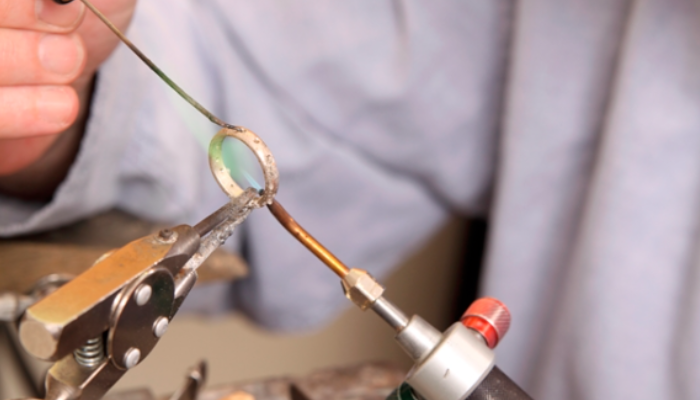
Stone Setting: Securing Precious Gems
Stone setting is both an art and a science. It’s crucial for keeping your precious gems secure and showcasing their beauty.
Types of Stone Settings in Jewellery
- Prong setting: Classic and popular, allows maximum light exposure
- Bezel setting: Surrounds the stone with a metal rim, very secure
- Channel setting: Stones are set in a channel between two metal walls
- Pavé setting: Many small stones set close together
- Tension setting: Stone appears to be held by pressure alone
Common Issues with Loose Stones
- Worn or damaged prongs
- Impact or trauma to the jewellery
- Poor initial setting
- Normal wear and tear over time
The Stone Setting Repair Process
- The jeweller examines the setting and stone
- They clean the piece thoroughly
- The setting is repaired or rebuilt as needed
- The stone is carefully reset
- The piece is polished and inspected
Preventive Care for Stone Settings
- Have your jewellery checked professionally every 6-12 months
- Avoid wearing rings while doing heavy work
- Remove jewellery before swimming or using harsh chemicals
- Store pieces separately to prevent scratching
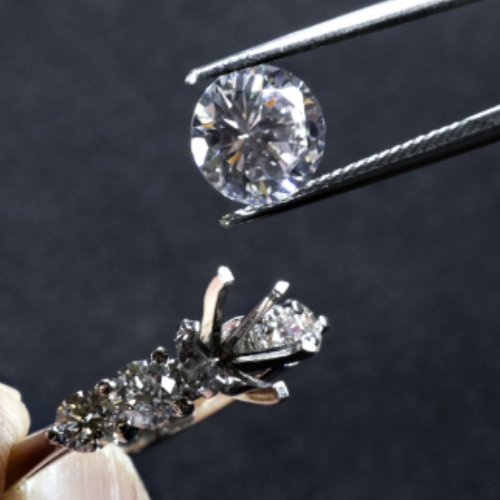
Prong Repair and Replacement
Prongs are tiny but mighty guardians of your precious stones. When they wear down or break, your gems are at risk.
The Role of Prongs in Jewellery
Prongs serve several important functions:
- Secure the stone in place
- Allow light to enter the stone, enhancing brilliance
- Elevate the stone for a more prominent display
Signs of Worn or Damaged Prongs
- Visible bending or misalignment
- Prongs catching on clothing
- Stone feels loose or moves in the setting
- Visible wear or thinning of the prongs
Prong Repair Techniques
- Retipping: Adding metal to worn prongs
- Tightening: Adjusting loose prongs
- Rebuilding: Recreating severely damaged prongs
When to Opt for Prong Replacement
Complete prong replacement may be necessary when:
- Multiple prongs are severely damaged
- The metal has become too thin to support retipping
- The overall integrity of the setting is compromised
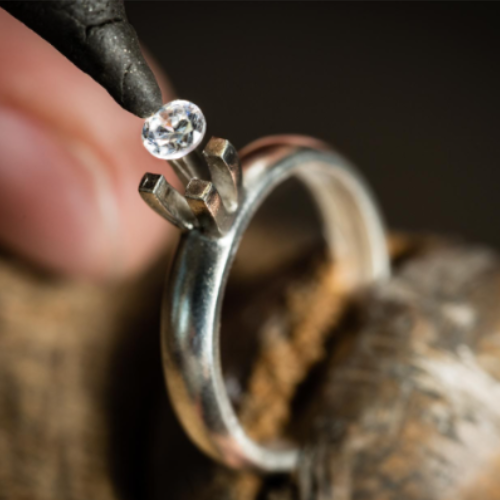
Jewellery Cleaning and Polishing
While not a repair in the traditional sense, professional jewellery cleaning and polishing can breathe new life into tired-looking pieces.
The Importance of Regular Cleaning
Regular cleaning:
- Removes dirt and oils that dull the appearance
- Allows for early detection of potential issues
- Maintains the overall health of the piece
Professional vs. At-Home Cleaning Methods
Professional cleaning:
- Ultrasonic cleaning for intricate pieces
- Steam cleaning for a deep clean
- Professional polishing for a high shine
At-home cleaning:
- Mild soap and warm water for most pieces
- Soft-bristled brush for gentle scrubbing
- Specialised jewellery cleaning solutions
Polishing Techniques for Different Metals
| Metal | Polishing Technique |
| Gold | Gentle buffing with a soft cloth |
| Silver | Silver polishing cloth |
| Platinum | Professional buffing wheel |
| Stainless Steel | Fine grit polishing compound |
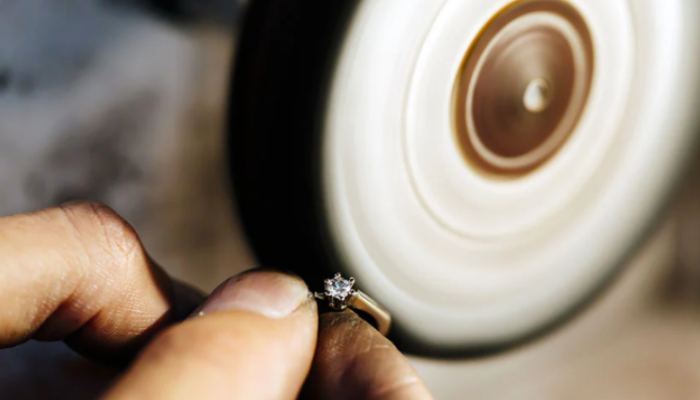
Repairing Antique and Vintage Jewellery
Antique and vintage pieces require special care and expertise. The goal is to repair while preserving the piece’s historical integrity.
Unique Challenges of Older Pieces
- Fragile or worn components
- Outdated construction techniques
- Rare or no longer available materials
- Potential historical or monetary value considerations
Balancing Restoration and Preservation
The key is to repair only what’s necessary to make the piece wearable and safe, while maintaining its original character. This might involve:
- Using period-appropriate materials
- Employing traditional repair techniques
- Documenting all repairs for future reference
Finding Specialists for Vintage Repairs
Look for jewellers who:
- Have experience with antique pieces
- Are knowledgeable about historical jewellery styles and techniques
- Are members of professional organisations like the Society of American Silversmiths
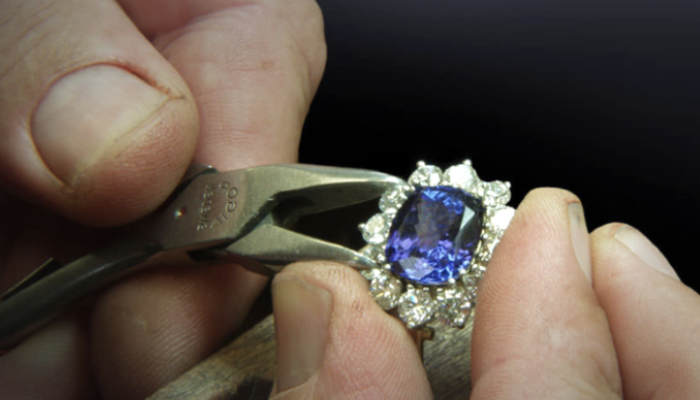
Soldering in Jewellery Repair
Soldering is a fundamental technique in jewellery repair, used to join metal components securely.
What is Soldering and When is it Used?
Soldering involves melting a metal alloy (solder) to join two metal pieces. It’s used in various repairs, including:
- Fixing broken chains
- Attaching new clasps
- Repairing splits in rings
- Securing loose components
The Soldering Process Explained
- The jeweller cleans the areas to be soldered
- They apply flux to prevent oxidation
- Small pieces of solder are placed at the joint
- Heat is applied until the solder melts and flows
- The piece is cooled and cleaned
Risks and Benefits of Soldering Repairs
Benefits:
- Creates a strong, permanent bond
- Can be nearly invisible when done correctly
- Allows for complex repairs
Risks:
- Can damage heat-sensitive stones if not done carefully
- May alter the appearance of the metal if overheated
- Requires skill to achieve a seamless result
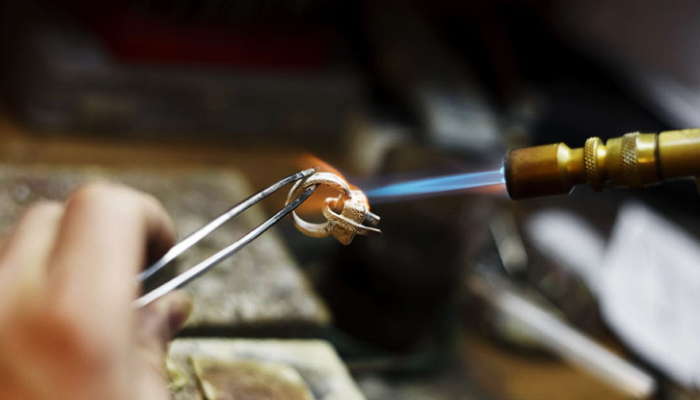
Plating and Refinishing
Over time, plated jewellery can wear, revealing the base metal underneath. Re-plating can restore the piece’s original appearance.
When Jewellery Needs Re-plating
- Visible wear or discoloration
- Allergic reactions to exposed base metal
- Desire to change the colour of the piece
Different Plating Options
- Gold plating: Available in various karats and colours
- Rhodium plating: Popular for white gold and silver
- Rose gold plating: For a trendy, warm look
- Silver plating: To refresh silver-toned pieces
The Replating Process
- The jeweller thoroughly cleans the piece
- Any necessary repairs are made
- The piece is degreased and prepared for plating
- It’s submerged in a plating solution
- An electric current is applied to deposit the new metal layer
- The piece is rinsed, dried, and polished
Care Tips for Plated Jewellery
- Remove before showering or swimming
- Avoid contact with harsh chemicals
- Store in a soft cloth to prevent scratching
- Clean gently with a soft brush and mild soap
Choosing a Jewellery Repair Service
Selecting the right jeweller is crucial for ensuring quality repairs and peace of mind.
What to Look for in a Reputable Jeweller
- Certifications and professional memberships
- Years of experience
- Positive customer reviews
- Transparent pricing and policies
- Willingness to explain the repair process
Questions to Ask Before Entrusting Your Piece
- What specific repairs does my piece need?
- How long will the repair take?
- What materials will be used?
- Do you offer a warranty on repairs?
- Can you provide before and after photos?
Understanding Repair Warranties
Many reputable jewellers offer warranties on their work. These may cover:
- Defects in workmanship
- Failure of the repaired component
- Follow-up adjustments
Be sure to understand the terms and duration of any warranty offered.
Balancing Cost and Quality in Jewellery Repairs
While it’s tempting to seek out the cheapest option, remember that quality repairs require skill, time, and proper materials. Investing in professional repairs from experienced jewellers like The Jewellery Mechanic can save money in the long run by preventing further damage and preserving your jewellery’s value.
DIY Jewellery Repair: What You Can (and Shouldn’t) Do at Home
While some minor maintenance can be done at home, it’s important to know your limits.
Simple Repairs for the DIY Enthusiast
- Basic cleaning with mild soap and water
- Polishing with a jewellery cloth
- Tightening earring backs
- Replacing watch batteries (for non-water resistant watches)
Essential Tools for Basic Jewellery Maintenance
- Soft-bristled brush
- Lint-free cloths
- Jewellery cleaning solution
- Magnifying glass
- Fine-tipped tweezers
When to Leave it to the Professionals
Always consult a professional for:
- Any repair involving heat or chemicals
- Stone setting or resetting
- Repairs on valuable or sentimental pieces
- Complex mechanisms like watch movements
Risks of Attempting Complex Repairs at Home
- Permanent damage to the piece
- Loss of stones or small components
- Voiding manufacturer warranties
- Potential injury from tools or chemicals
Conclusion: The Value of Regular Maintenance
Understanding common jewellery repairs empowers you to care for your precious pieces properly. Regular maintenance and timely repairs not only keep your jewellery looking beautiful but also preserve its value and sentimental significance for years to come.
Remember, whether you’re dealing with a simple clasp replacement or intricate stone setting, professional jewellery repair services by The Jewellery Mechanic can ensure your pieces receive the expert care they deserve. Don’t wait until a small issue becomes a big problem – make jewellery maintenance a regular part of your routine.
By following these guidelines and seeking professional help when needed, you can ensure your jewellery remains beautiful, functional, and cherished for generations to come. Whether it’s a family heirloom or a recent purchase, every piece of jewellery tells a story. With proper care and timely repairs, you can ensure that story continues for years to come.
FAQs About Jewellery Repairs
Q: How much does jewellery repair typically cost?
A: Costs vary widely depending on the type of repair, materials used, and complexity of the work. Simple repairs like chain soldering might start around £20, while more complex work like vintage restoration could cost hundreds.
Q: How long do most jewellery repairs take?
A: Turnaround times can range from same-day service for simple repairs to several weeks for complex restorations. Always ask your jeweller for an estimated timeline.
Q: Can all types of jewellery be repaired?
A: Most jewellery can be repaired, but some materials and designs pose challenges. Alternative metals like tungsten, for example, often can’t be resized.
Q: What should I do if my jewellery is damaged beyond repair?
A: Even if a piece can’t be restored to its original state, a skilled jeweller might be able to repurpose the materials into a new design.
Q: How often should I have my jewellery professionally checked?
A: It’s recommended to have fine jewellery checked by a professional every 6-12 months, or more frequently for pieces worn daily.
By following these guidelines and seeking professional help when needed, you can ensure your jewellery remains beautiful, functional, and cherished for generations to come.
